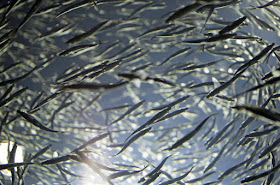Fishmeal used to hold an important position as a constituent of pig and poultry diets, but use in the sector declined as the aquaculture sector developed and sourced an increasing proportion of global supply of this marine ingredient. With fishmeal now regarded as less of a commodity and more of a strategic protein, another look at the benefits of this high value material is warranted.
by Neil Auchterline
First published in Milling and Grain, April 2016
Fishmeal is a highly nutritious animal feed ingredient, possessing both excellent digestibility and comparatively high protein levels with good amino acid profiles. It is a resource that plays a key role in global food security, supporting both aquaculture and agriculture production systems. As well as having a valuable macronutrient profile, fishmeal also contains some important micronutrients such as the polyunsaturated fatty acids eicosapentaenoic acid (EPA) and docosahexaenoic acid (DHA), both of which have been linked to immune-competence in pigs, see Palmer, (2002). Fishmeal is also a good source of selenium, iodine, calcium and phosphorus.
Fishmeal supply
The global annual supply of fishmeal currently is approximately 5m MT, with approximately 68 percent going into aquaculture feeds, 25 percent into pig feeds, 5 percent into chicken feeds and 2 percent classified as “other” (e.g. turkey, game birds), see Fig.1. It is produced principally from reduction fisheries exploiting fast-growing, small, pelagic fish species such as anchovy or menhaden, although a significant and increasing proportion of global supply comes from the byproducts from the processing of fish for human consumption.
Species typical of reduction fisheries include the Peruvian anchovy (Engraulis ringens), Atlantic menhaden (Brevoortia tryannus), Gulf Menhaden (Brevoortia patronus), capelin (Mallotus villosus), sandeels (Ammodytes sp.), boarfish (Capros aper) and blue whiting (Micromesistius poutassou). Peruvian anchovy dominates global production, and was the top ranking species produced in 2012 (FAO, 2014). That species, and many of the other species utilised tend to have a relatively high level of fish oil, which is another important product from the marine ingredients industry a large proportion of which goes into aquafeed production or for direct human consumption. In most cases exploitation of the fishery is through a quota management system, where annual recruitment of the stock is assessed, and an allowable catch calculated and set, based on long-term sustainable management goals.
Read the full article in Milling and Grain HERE.
by Neil Auchterline
First published in Milling and Grain, April 2016
Fishmeal is a highly nutritious animal feed ingredient, possessing both excellent digestibility and comparatively high protein levels with good amino acid profiles. It is a resource that plays a key role in global food security, supporting both aquaculture and agriculture production systems. As well as having a valuable macronutrient profile, fishmeal also contains some important micronutrients such as the polyunsaturated fatty acids eicosapentaenoic acid (EPA) and docosahexaenoic acid (DHA), both of which have been linked to immune-competence in pigs, see Palmer, (2002). Fishmeal is also a good source of selenium, iodine, calcium and phosphorus.
Fishmeal supply
The global annual supply of fishmeal currently is approximately 5m MT, with approximately 68 percent going into aquaculture feeds, 25 percent into pig feeds, 5 percent into chicken feeds and 2 percent classified as “other” (e.g. turkey, game birds), see Fig.1. It is produced principally from reduction fisheries exploiting fast-growing, small, pelagic fish species such as anchovy or menhaden, although a significant and increasing proportion of global supply comes from the byproducts from the processing of fish for human consumption.
Species typical of reduction fisheries include the Peruvian anchovy (Engraulis ringens), Atlantic menhaden (Brevoortia tryannus), Gulf Menhaden (Brevoortia patronus), capelin (Mallotus villosus), sandeels (Ammodytes sp.), boarfish (Capros aper) and blue whiting (Micromesistius poutassou). Peruvian anchovy dominates global production, and was the top ranking species produced in 2012 (FAO, 2014). That species, and many of the other species utilised tend to have a relatively high level of fish oil, which is another important product from the marine ingredients industry a large proportion of which goes into aquafeed production or for direct human consumption. In most cases exploitation of the fishery is through a quota management system, where annual recruitment of the stock is assessed, and an allowable catch calculated and set, based on long-term sustainable management goals.
Read the full article in Milling and Grain HERE.
The Global Miller
This blog is maintained by The Global Miller staff and is supported by the magazine GFMT
which is published by Perendale Publishers Limited.
For additional daily news from milling around the world: global-milling.com


No comments:
Post a Comment